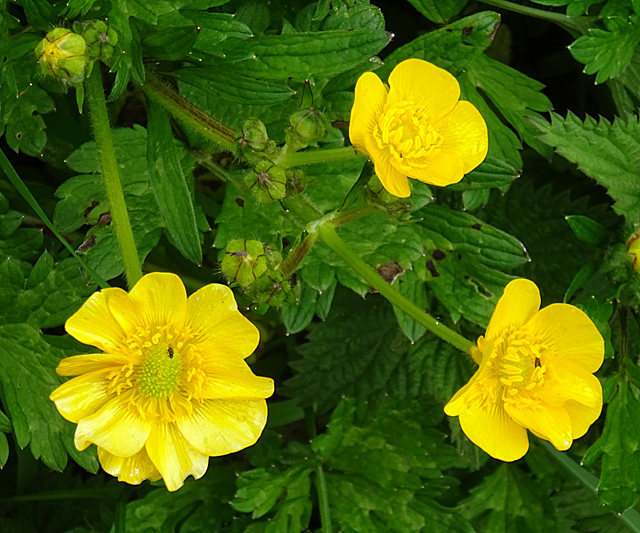Ranunculus repens
Description
Creeping buttercup can be distinguished from other buttercups by the spreading way it grows with runners (Tall buttercup looks similar but lacks creeping stolons).
- General: Perennial herb with creeping, hairy stems up to 100 cm long.
- Leaves: Egg-shaped to triangular, hairy, divided into three lobes with frayed edges, with pale spots.
- Flowers: Bright yellow, 5-9 petals, 2cm across.
- Fruits: Globe-shaped with prominent, beaked achenes.
Introduction and spread
- Introduction and Spread: Introduced from Eurasia, creeping buttercup is now widespread in Canada and the US. Common in SW BC, it thrives in heavy, wet clay soils but can also grow in sandy or gravelly areas if moisture is sufficient. It can be found in disturbed areas like streams, wetlands, forest openings, and paths.
- Reproduction: Reproduces by seed and vegetatively through stolons that root at nodes. Stolon growth peaks in late summer. Flowers from March to August, with seeds viable for up to 80 years.
Consequences of invasion
- Toxic to grazing animals; causes pain and irritation.
- Spreads aggressively, up to 40 sq. ft. in a year.
- Depletes potassium and other soil nutrients.
- Outcompetes native plants in wet, grassy areas.
- Reduces pasture capacity; aggressive in crops and landscapes.
Status in the CKISS region
- This species is not listed on the CKISS Annual Priority List.
- To learn more about how CKISS classifies and manages invasive species, see our Invasive Species Priority Lists page.
Integrated pest management options
Prevention
- Be PlantWise! Choose plants that are not invasive by Growing Me Instead!
- Maintain healthy, competitive vegetation.
- Patrol and remove creeping buttercup before it seeds.
- Improve drainage and avoid moving contaminated soil.
- Clean equipment after working in infested areas.
Mechanical Control
- Manual Techniques: Dig or pull small infestations, removing as much of the plant and root fragments as possible. Repeat control efforts as needed to manage resprouts.
- Grazing Management: Avoid overgrazing and rotate grazing to prevent buttercup establishment.
- Cultivation: Weaken plants through cultivation, but note they may regenerate from rootstock and stolons. Plowing is not recommended as it can encourage seed germination.
- Disposal: Properly dispose of plant material by bagging and removing it from the site to prevent reestablishment.
Chemical Control
- Chemical control may be an option. Consult a professional to determine whether this option is right for you.
- Use systemic herbicides; follow label instructions.
- Glyphosate, MCPA, and Aminopyralid are effective options.
Biological Control
- No biological control agents available in BC.
Cultural Control
- Clean equipment, aerate soil, and overseed to outcompete buttercup.
Additional resources
King County Noxious Weed Alert- Creeping buttercup factsheet
Alaska Center for Conservation Science – Creeping buttercup factsheet
E-Flora BC: Electronic Atlas of the Flora of British Columbia – Creeping buttercup profile
Invasive Species Online Okanagan – Creeping buttercup
Wildlife Trust – Creeping buttercup profile







